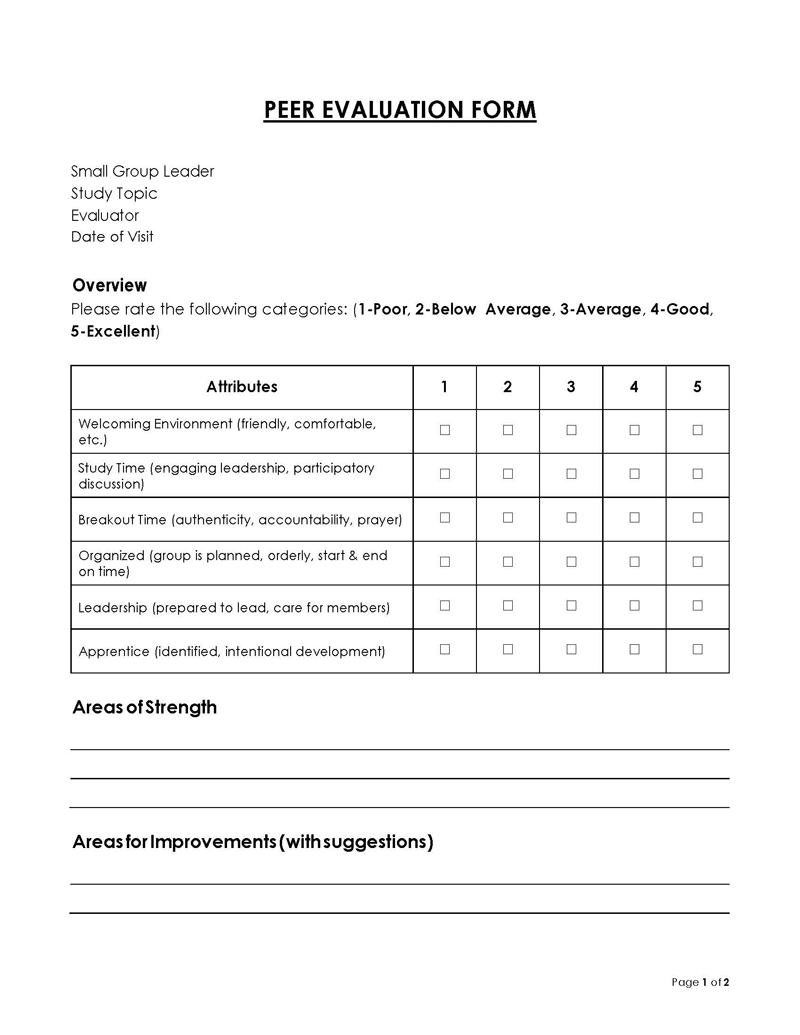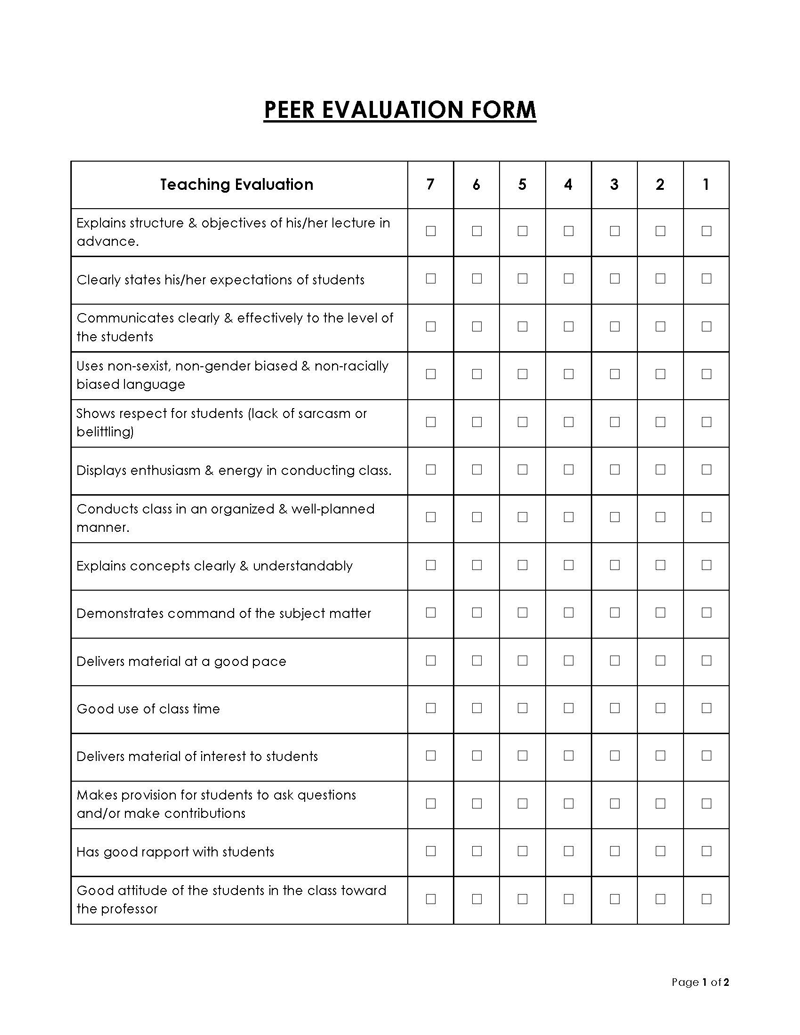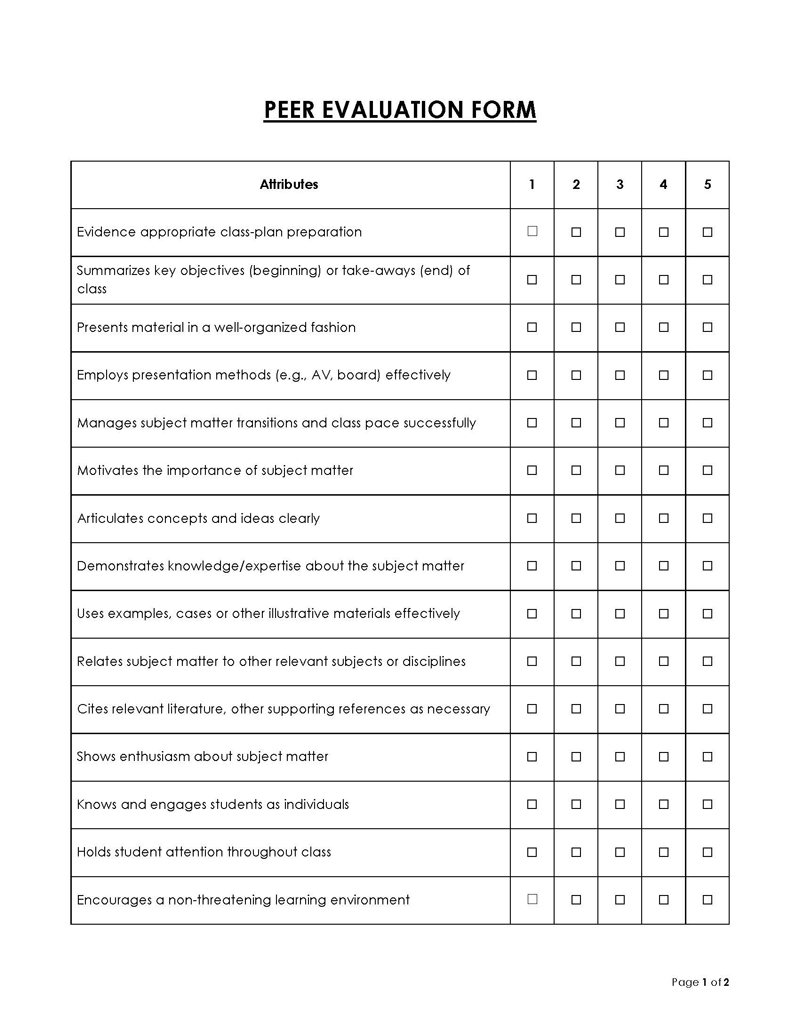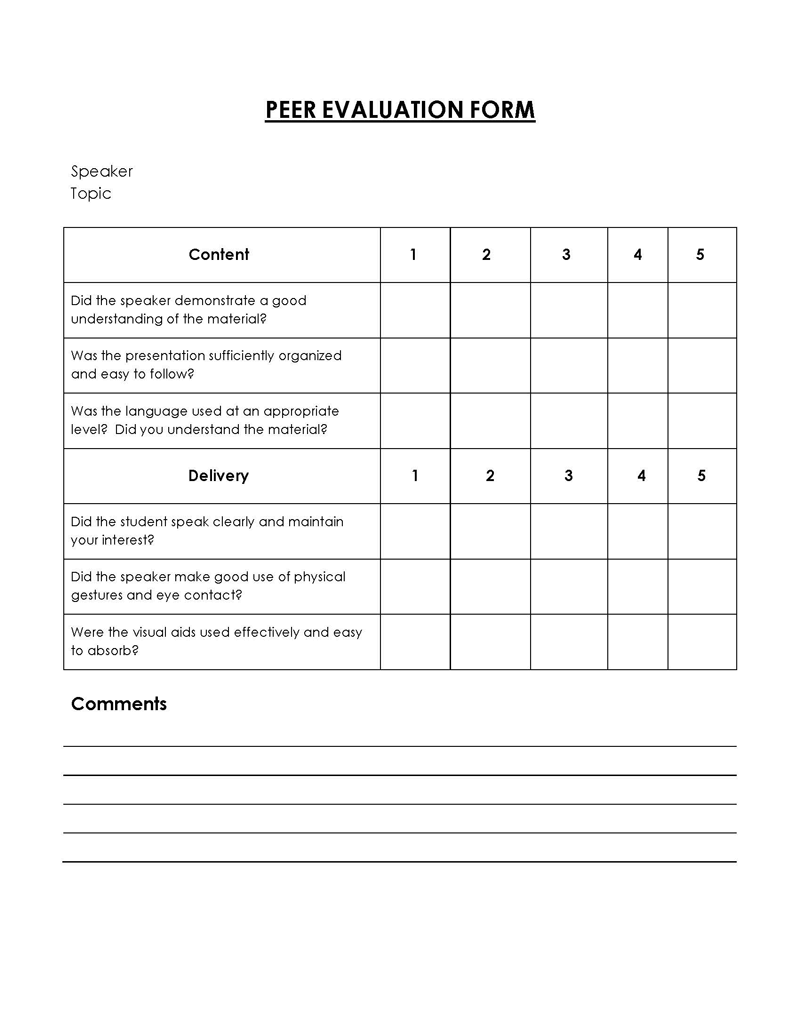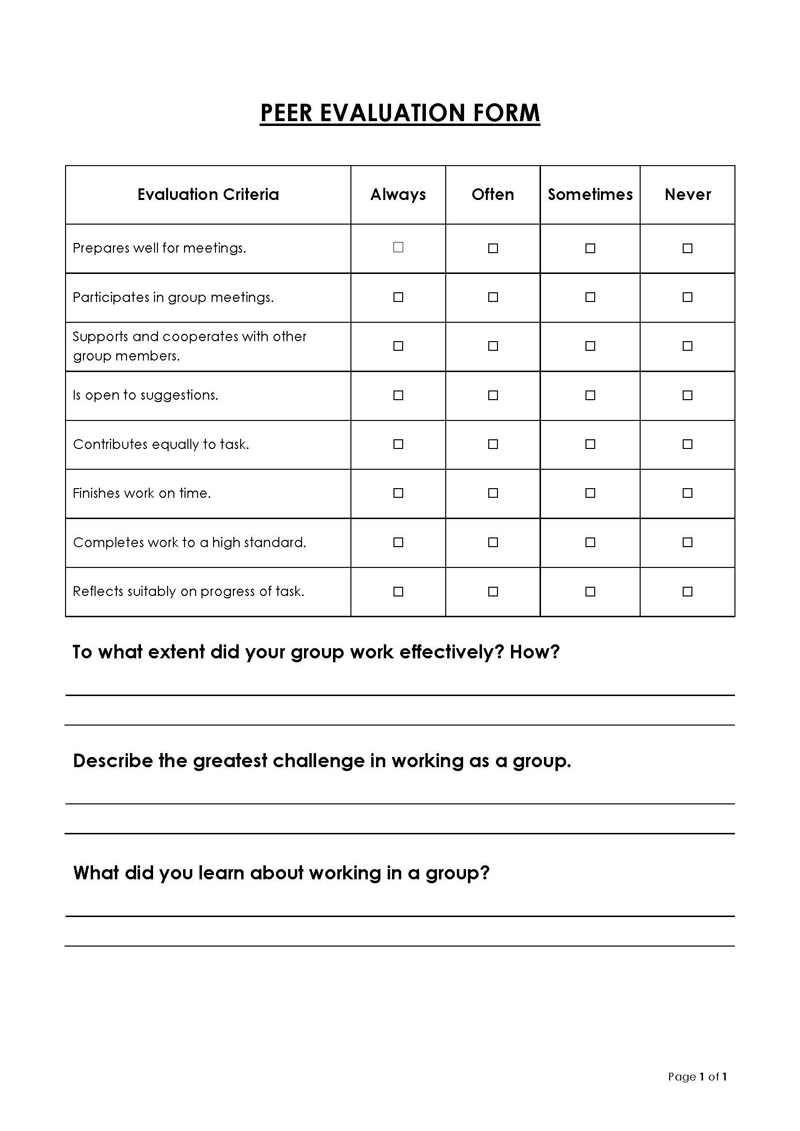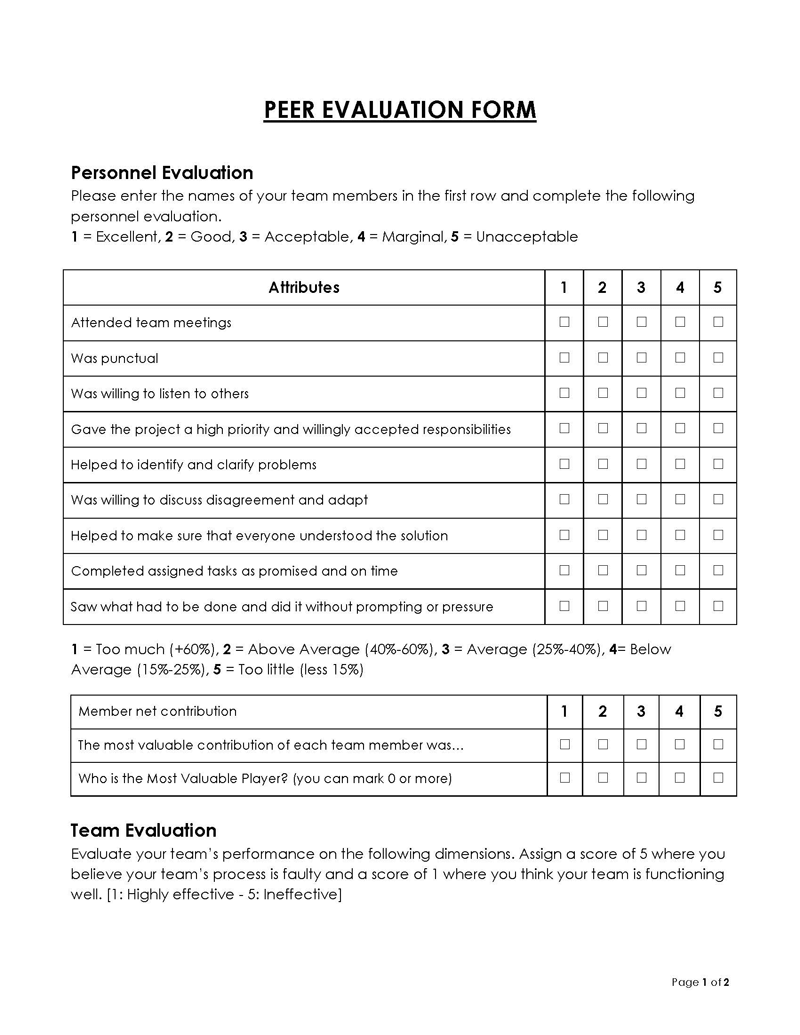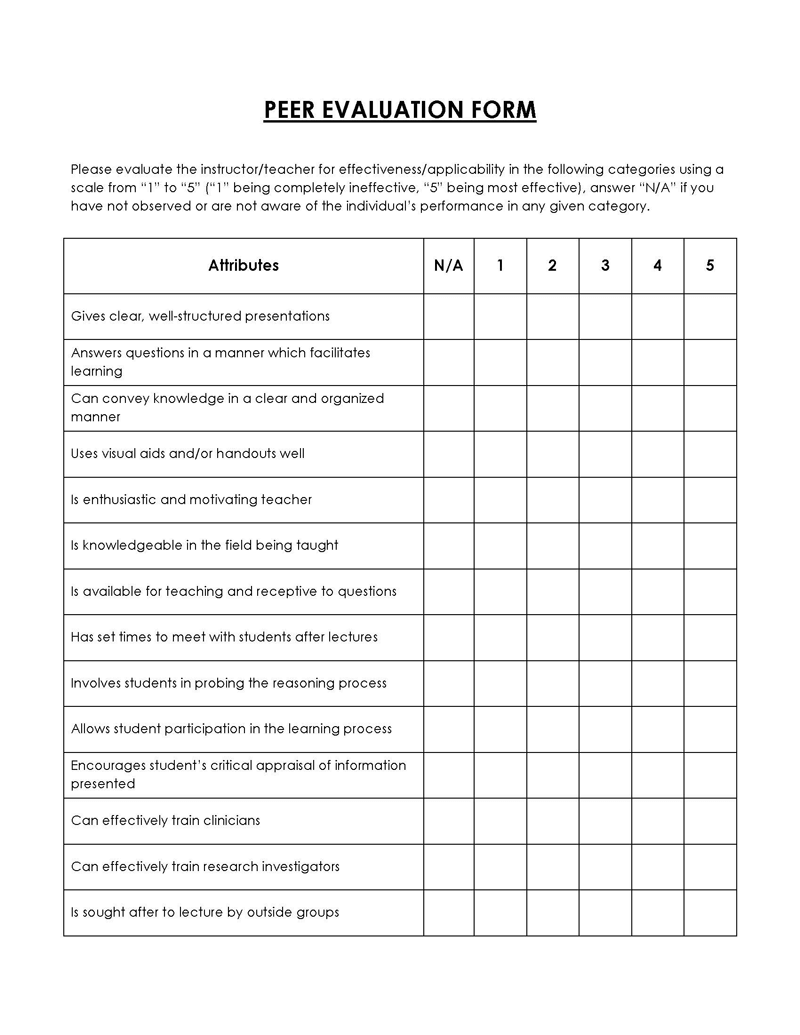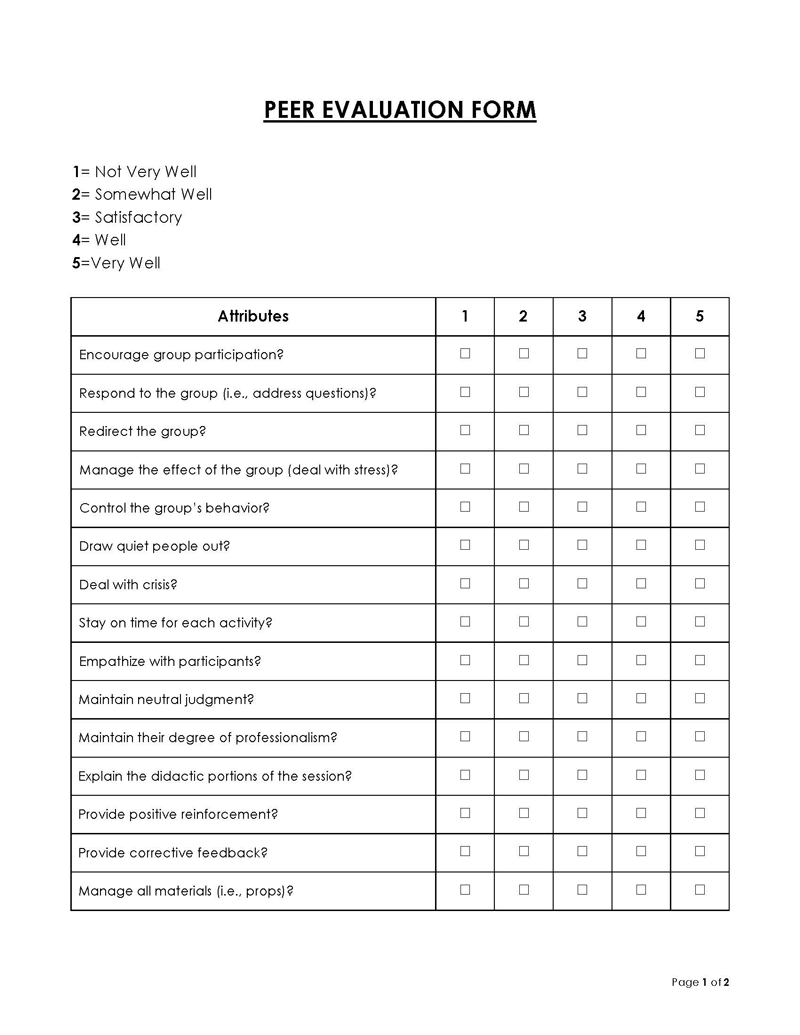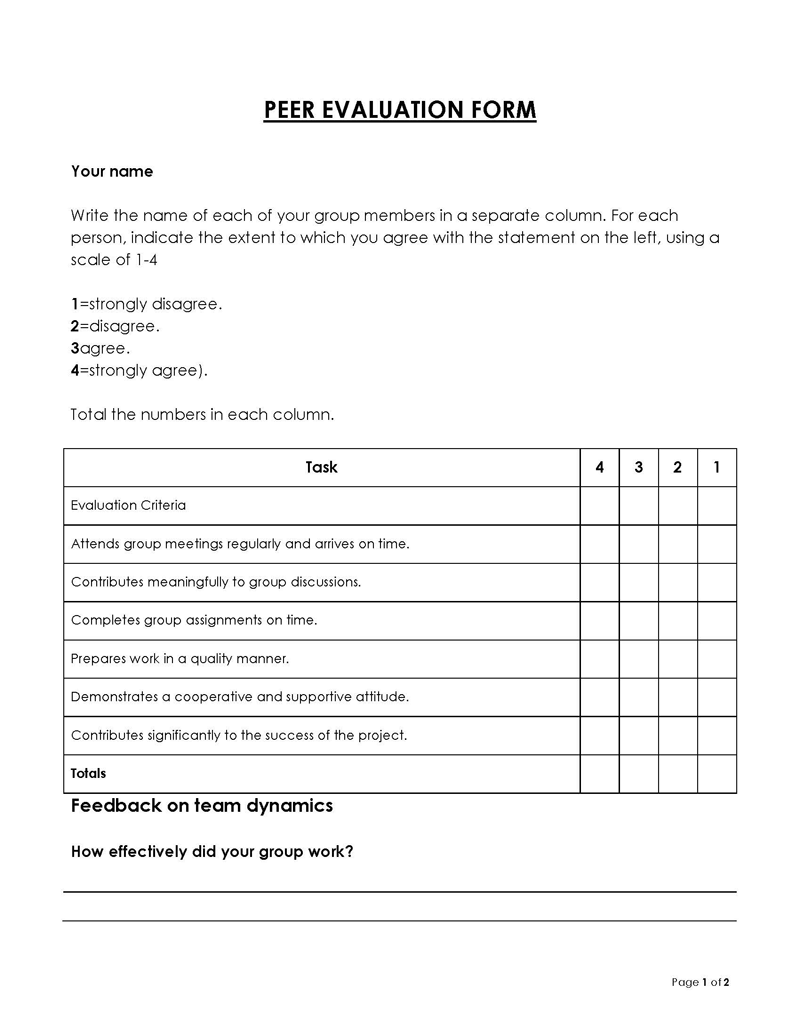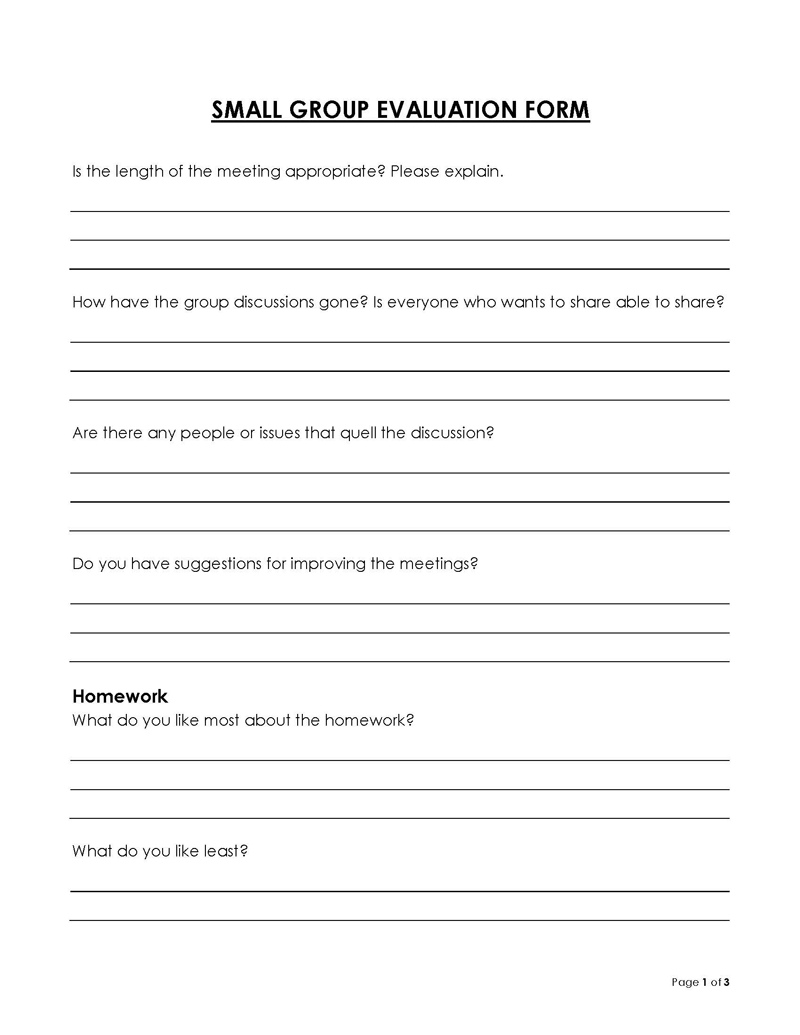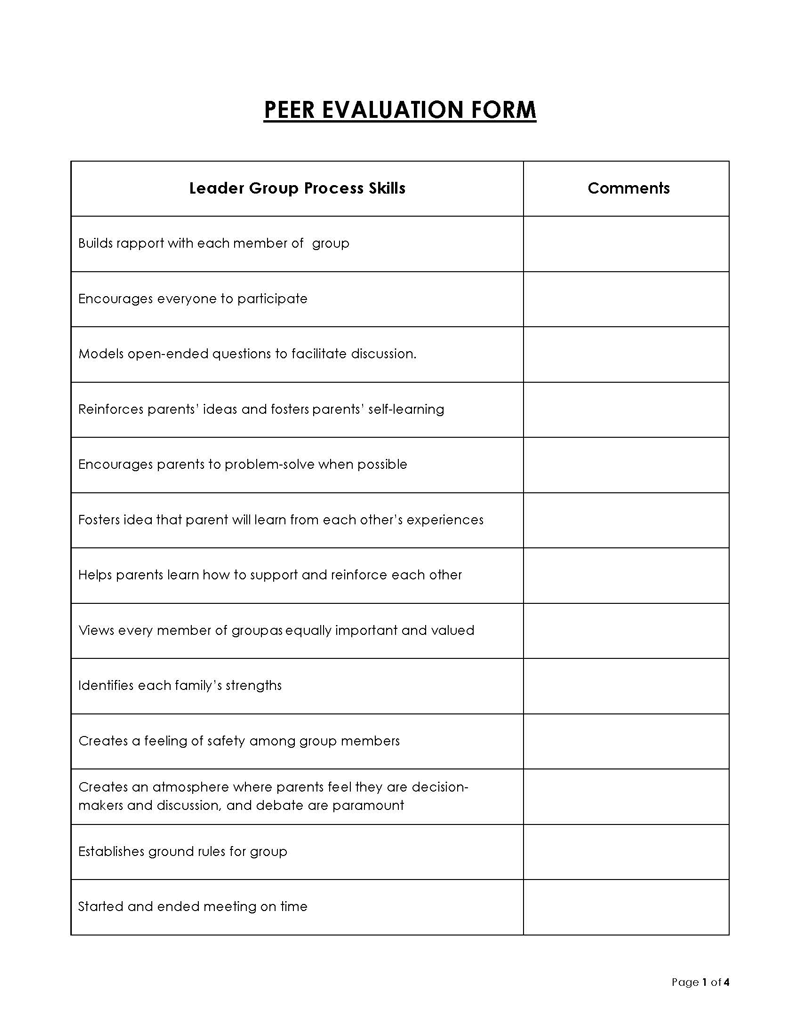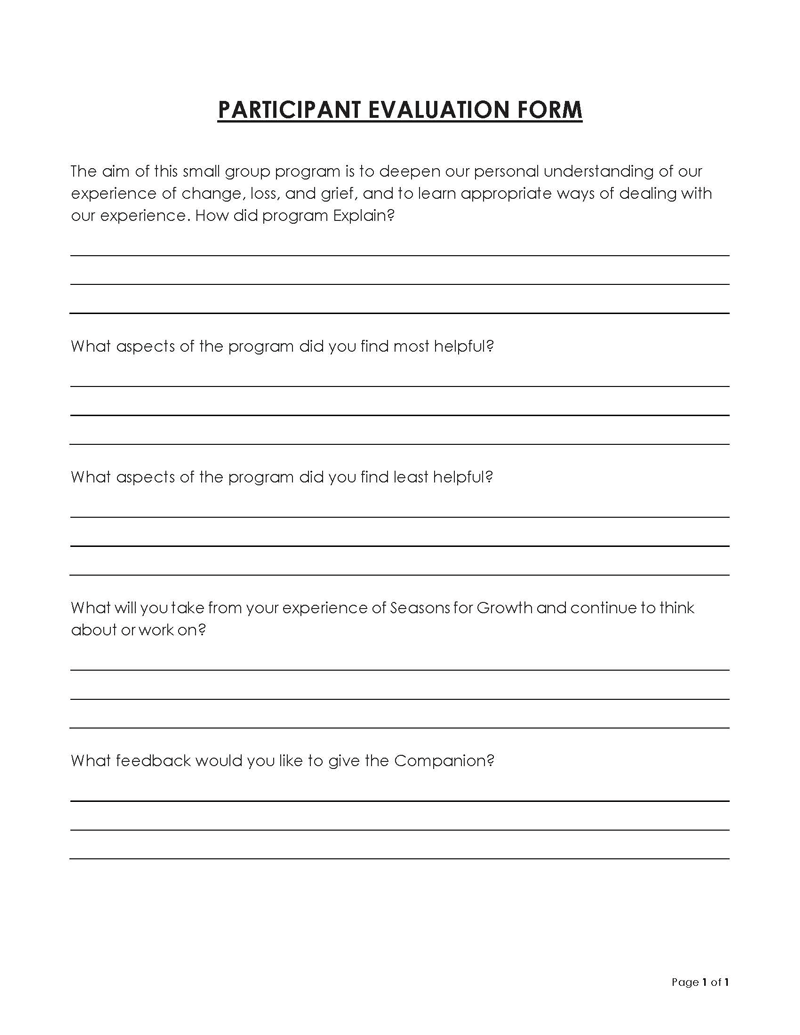Peer evaluation is a process that enables you to give an honest assessment of your colleague’s performance. It is an activity carried out by one or more individuals who occupy jobs of the same level in an organization and belong to the same teams or departments. Peer evaluation is also done in schools by enabling children to assess each other’s work and give their opinions. In organizations, evaluation is usually done by the Human Resources department as part of the 3600 assessments, where you may be called to give information about your workmate.
Peer evaluation is essential since it lets you identify your colleague’s strengths and weaknesses to help decide the next action. This ensures that each person performs according to the standards set in an organization, guaranteeing an improvement in their performance and productivity. Peer evaluation also helps to identify the nature of workplace relationships from employees’ comments about each other.
Peer Evaluation Form Templates
It is vital to conduct proper evaluations because they help your colleagues understand their performance. Also, they allow you to identify areas of concern in their performance which helps formulate solutions that increase their productivity. This site gives you access to various free peer evaluation form templates, which can be downloaded and customized to create the perfect evaluation form. These peer evaluation forms greatly assist since they help collect relevant information during evaluation.
Types of Peer Evaluation
Peer evaluation can be adopted in various institutions to help maintain and improve performance standards. It involves the assessment of individuals’ performance in different aspects of the activities carried out in the institutions, making it necessary to specify and communicate the aspects being assessed.
The following are some common types of peer evaluation:
Student peer evaluation
Peer evaluations are common in schools to ensure students perform well in all aspects of their school life. When conducting student peer evaluations, the teacher decides how you assess each other by picking the evaluation criteria. This ensures that the evaluation is done systematically, making it more effective. In addition, it is essential because it helps to become aware of the aspects evaluated when grading.
Pros
Student peer evaluations are beneficial since they help teachers ensure that their students perform exemplarily in all learning aspects. This allows them to maintain high-performance levels and improve in areas of concern.
Other benefits include:
- Students get to assess each other on what they have learned, which helps them understand better.
- It helps to know whether students have understood the teachings.
- It allows students to interact with each other, enabling them to learn from each other.
Cons
Despite being beneficial, student peer evaluations can impact your students negatively. The main disadvantages of student peer evaluations include the following:
- Some students may not agree with each other, leading to negative criticism.
- Students are not experienced in conducting evaluations, and without the proper guidance, they may submit evaluations that are not helpful.
- Students may give negative evaluations which do not please their peers. This can hinder cohesion and form negative relationships between students.
Employee peer evaluation
It is an assessment of your colleague’s performance at your workplace. It is often conducted between employees in the same teams or departments, allowing you to comment on different aspects of their work. Such evaluations at the workplace usually follow guidelines that are put in place to ensure that all employees understand how to evaluate each other. Peer evaluations in most organizations are conducted anonymously to maintain the existing relationship between its employees. However, some organizations have a culture where peer evaluations are done openly without anonymity.
Pros
An organization performs better when peer evaluations are conducted among employees. This is because evaluations help employees do their work with greater efficiency.
Other pros include the following:
- Employee peer evaluation gives helpful information about your colleague’s performance.
- Employee evaluation allows employees to identify their strengths and weaknesses and work on them to improve their productivity.
- Employee evaluations help in reviewing operations in an organization.
- Evaluations at the workplace identify ways to increase the performance of teams.
Cons
Peer evaluations should be conducted keenly in organizations for them to be helpful. However, there may be hindrances that may prevent the evaluations from being effective, including:
- Employees may be friends, which can lead to the submission of evaluations that do not clearly show their weaknesses.
- Employees with poor relationships may give false negative comments in evaluations, making them unreliable.
Peer journal/ Article assessment
Peer journal assessments are carried out by scholars seeking to approve an author’s academic work in their field. This is because the work contains vital research information that is widely used by the public, and it is essential to ensure that the information is accurate. In addition, academic works relate to different fields of study, and particular specifications must be met to be accepted and published. This makes it necessary for you to evaluate whether the work meets the specifications put in place.
Pros
Peer journal evaluations are vital in ensuring that scholars publish quality work. Other benefits of peer journal assessments include:
- Peer article assessments ensure that publications made for academic materials are accurate and contain valid and valuable information.
- It allows you to give feedback on academic work, and valuable information may be added in the process.
- Peer article assessments facilitate the verification of academic materials before publication.
Cons
Peer journal evaluations are mandatory in the verification of published work. However, there are instances when they negatively impact the process.
They include:
- Peer journal assessments may take a while before it is concluded. This is because sometimes, the information may become outdated before publication.
- It is costly to conduct peer journal assessments.
- Scholars may not have a good relationship, leading to misleading and biased evaluations.
How to Conduct a Peer Evaluation?
Peer evaluation should be done keenly since the information helps maintain employees’ performance at the standards. In addition, a proper evaluation enables you to identify areas where your colleagues need improvement, allowing you to address the problem by coming up with practical solutions.
The following will guide you on how to conduct a successful peer evaluation:
Follow clear guidelines
Peer evaluations should be done uniformly by ensuring that the same aspects are assessed. This is done by following the guidelines for the evaluation process and specifying the assessment criteria used.
Demand enough time
It is essential to carry out thorough evaluations since the information obtained is vital. Therefore, enough time will be needed to allow you to evaluate adequately. You should also ensure that evaluation forms are submitted to reviewers earlier than the evaluation date, enabling them to prepare satisfactory evaluation results.
Conduct anonymously
Evaluations should be conducted anonymously by ensuring the employees do not know who evaluates them. This is because the employees may be uncomfortable with the comments made by their reviewers, and knowing them can negatively impact their relationship, undermining team spirit at the workplace.
Create familiarity with evaluation parameters
When conducting evaluations, you should be aware of the evaluation parameters to participate in fair evaluations. This allows you to understand the expectations and avoid making irrelevant evaluations.
Best Practices to Consider
For your evaluation to yield the best results, there are essential things that you should keep in mind. These practices allow you to assess your colleagues adequately, enabling you to provide valuable information that can improve their performance.
The practices include:
Encourage honest feedback
Your evaluation should result in sincere feedback that helps formulate the appropriate solutions to any identified issues. This is because failing to mention your colleague’s weaknesses prevents them from being aware of the weaknesses they need to work on. Also, your manager may discover when you hide your colleague’s flaws in evaluations, which can land you in trouble. At times, surveys may be used during evaluations, and you should ensure that the questions asked do not indicate unfairness in your evaluations.
Support your assertions with data
It is essential to back your assessments with figures because they help you give a reliable evaluation that has proof. Also, any person going through your evaluations can better understand what you are trying to communicate, making it more effective.
Do not rush
The feedback in your evaluations is vital because it is used to determine further actions toward the colleague you evaluated. Therefore, when writing your evaluations, it is essential to consider your choice of words by ensuring that they are structured in a way that helps your colleague identify ways in which their performance can be improved.
Keep your grudges aside
You may need to evaluate a colleague you are used to disagreeing with, making it challenging to evaluate them effectively. It is vital to keep aside the status of your relationship with your colleagues and only focus on their performance when handling their work responsibilities.
Use ‘I’ instead of ‘You.’
When giving evaluations, you must avoid blaming your colleagues for their actions. Pointing out what they did makes them defensive and makes the evaluation lose its significance. Instead, expressing your opinion on the employee’s actions is essential to help them understand why you have reached that conclusion.
For example:
Instead of “Kennedy was rude to his supervisor when he was asked about lateness,” you can write, “ I think Kennedy did not handle himself appropriately because of the tone he used when answering his supervisor.”
Be specific
Your evaluations should focus on your colleague’s actions rather than past disagreements. This helps you from submitting wrong evaluations which give wrong information about your fellow employees.
Comment on behavior, not personality
Ensure that your evaluations comment on how your colleague works rather than the type of person they are. However, there are instances when elements of their personality affect how others perform in the department or team, and it is vital to mention them in your evaluation.
Avoid the use of ‘But.’
Positive comments are bound to lose their significance when you insert ‘but’ and add a negative comment after. This is because your comments may sound untrue. If you need to mention a flaw, you may add the word ‘what if’ and provide a solution to the issue you are addressing.
Advantages and Disadvantages of Peer Evaluation
Peer evaluation is essential because it allows you to control your colleague’s performance by identifying areas where there may be deficiencies and formulating solutions. However, it can have some negative implications when executed, and it is essential to have an idea of them to mitigate them.
Such evaluations have the following advantages and disadvantages:
Advantages
Peer evaluations should be conducted in schools and organizations because they help manage students’ and employees’ performance. Other instances where it is of assistance include:
- Peer evaluation helps you better understand employees at your workplace since you know the factors that affect their performance.
- It allows you to understand employee relationships and interactions and reveals their strengths and weaknesses, which can be used to formulate ways to increase their productivity.
- When employees are assessed by their colleagues, they are motivated to work better because they would not want to be seen as incompetent.
- Evaluations made by your colleagues help improve performance more because the comments made are easier to relate to, allowing you to work on your weaknesses.
- Peer evaluation allows children to learn how to analyze and comment on their performance and that of their friends, enabling them to learn a new skill that can be useful in their lives.
- Evaluation makes children responsible for their learning by ensuring they know what they need to improve.
- When students assess each other, they encounter what they have previously learned, which helps them retain the knowledge gained.
- Peer evaluations enable children to interact when assessing each other. This allows them to get used to sharing ideas, giving them the confidence to participate in groups and teams.
- Students receive vital information when doing evaluations, and they can use this information to ensure that they do not repeat the same mistakes their peers make.
- Peer evaluations help students understand how they are graded since they know the criteria for grading them.
Disadvantages
Peer evaluations may sometimes be unhelpful and cause more harm than good. This may come because of conducting poor evaluations. The following are instances where peer evaluations may be disadvantageous:
- Peer evaluation is ineffective when it is conducted between friends because the comments are inclined to portray that their performance is perfect.
- Peer evaluations may take a significant amount of time, making your employees feel that they have too much work on their hands, affecting their normal responsibilities at the workplace.
- Employees at workplaces usually interact with each other, and as a result, they may create bonds that make them feel uncomfortable evaluating their colleagues.
- You may need to evaluate a colleague with whom you are not on good terms. However, this can make you conduct a biased assessment, making it impossible to improve their performance through evaluations.
- Children may be unable to express each other’s faults, leading to the submission of overly optimistic evaluations. Therefore, it is essential to teach learners constructive criticism so that they give better and more accurate evaluations.
- Children lack experience in evaluation, and this can make them submit evaluations that contain irrelevant information.
Conclusion
Peer evaluations are essential in schools and workplaces because they help you assess your colleague’s performance in different aspects and comment on them. These comments identify any shortcomings, allowing you to come up with appropriate solutions to help them tackle the issues. This helps ensure that your colleagues perform according to the desired standards, and their performance may be improved in cases where they do not.
It is essential to ensure that your evaluations are free from bias and irrelevant information by following guidelines issued concerning the evaluations. These guidelines give you the criteria to assess your colleagues to ensure that your evaluations are relevant and can be used in performance management. Also, be honest in your evaluations to enable your colleagues to be aware of any issues of concern and work on them.
